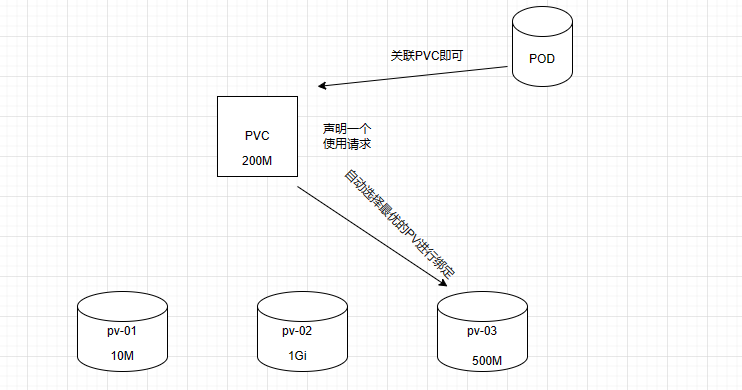k8s常用命令
節(jié)點(diǎn)加入集群生成新的token:
kubeadm token create --print-join-command
查詢資源的描述信息,也就是yaml的字段意思(這里以deployment為例子):
kubectl explain deployment
kubectl explain deployment.spc
1.命名空間 namespace /ns
方式:1
創(chuàng)建:kubectl create ns hello-ns
刪除:kubectl delete ns hello-ns
查詢:kubectl get ns
方式2:萬能通用方式:通過yaml模板創(chuàng)建 : 創(chuàng)建ns-ceate.yaml
apiVersion: v1
kind: Namespace
metadata:
name: hello
創(chuàng)建: kubectl apply -f ns-create.yaml
刪除:kubectl delete -f ns-create.yaml
2.pod相關(guān)命令
方式1:命令行創(chuàng)建
創(chuàng)建:kubectl run nginx --image=nginx
查看:kubectl get pods -A -o wide
查詢詳情:kubectl describe pod pod名稱
刪除: kubectl delete pod nginx
查詢?nèi)萜魅罩荆?kubectl logs -c 容器名稱 pod名稱
進(jìn)入pod的某個(gè)容器:kubectl exec -it pod名稱 -c 容器名稱 -- 命令:如 kubectl exec -it nginx -c nginx -- /bin/bash
方式2:萬能方式: 創(chuàng)建:kubectl apply -f xxx.yaml 刪除 kubectl delete -f xxx.yaml
apiVersion: v1 kind: Pod metadata: name: nignx_tomcat labels: app: nignx_tomcat namespace: hello spec: containers: - name: nginx image: nginx imagePullPolicy: IfNotPresent - name: tomcat image: tomcat:8.5.68 imagePullPolicy: IfNotPresent restartPolicy: Always
3.deployment部署相關(guān)
方式1.:
創(chuàng)建部署 kubectl -n hello create deploy my-first-deploy --image=nginx --replicas=3
刪除部署:kubectl delete deploy my-first-deploy -n hello
擴(kuò)容和縮容:kubectl scale deploy --current-replicas=3 --replicas=4 my-first-deploy -n hello
滾動(dòng)更新:kubectl set image deploy mydeployment ngnix-deplyment=nginx:1.9.1 -n hello
查詢滾動(dòng)更新的狀態(tài): kubectl rollout status deploy mydeployment -n hello
查詢滾動(dòng)更新的歷史記錄: kubectl rollout history deploy mydeployment -n hello
回滾到某一個(gè)版本: kubectl rollout undo deployment mydeployment --to-revision=1 -n hello
方式2:萬能方式: 創(chuàng)建:kubectl apply -f xxx.yaml 刪除 kubectl delete -f xxx.yaml 擴(kuò)容縮容 kubectl edit deployment xxx -n hello
apiVersion: apps/v1
kind: Deployment
metadata:
name: mydeployment
namespace: hello
labels:
app: mydeployment
spec:
replicas: 3
template:
metadata:
name: mydeply
labels:
app: mydeply
spec:
containers:
- name: ngnix-deplyment
image: nginx
imagePullPolicy: IfNotPresent
- name: tomcat-deplayment
image: tomcat:8.5.68
imagePullPolicy: IfNotPresent
restartPolicy: Always
selector:
matchLabels:
app: mydeply
3.服務(wù)service的創(chuàng)建
方式1.通過命令行方式創(chuàng)建:
創(chuàng)建service: 將一個(gè)deployment暴露成一組服務(wù) 1.默認(rèn)模式基于clusterIp 先查詢deployment的標(biāo)簽 kubectl get deploy --show-labels -A 找到對應(yīng)的標(biāo)簽名稱開始創(chuàng)建(-n hello表示命名空間為hello): kubectl expose deployment my-nginx --port=8088 --target-port=80 --type=ClusterIp -n hello 集群內(nèi)才能訪問(查詢服務(wù)的IP) kubectl get svc -n hello 最后訪問:http://服務(wù)的ip:8088 其他pod內(nèi)部訪問:服務(wù)名稱.命名空間:8088 如這里的是 http://my-nginx.hello:8088 2. 基于NodePort (比clusterIp方式多了一種訪問方式節(jié)點(diǎn)Ip:端口) 創(chuàng)建方式:kubectl expose deployment my-nginx --port=8088 --target-port=80 --type=NodePort -n hello
方式2.萬能公式,通過yaml模式創(chuàng)建 kubectl apply -f xxx.yaml 刪除 kubectl delete -f xxx.yaml
apiVersion: v1 kind: Service metadata: name: hello-service namespace: hello spec: selector: app: mydeply #這里的標(biāo)簽要跟deployment中的pod標(biāo)簽對應(yīng)而不是跟deployment的標(biāo)簽對應(yīng),可以過kubectl get pod --show-labels -A 查詢pod的標(biāo)簽 ports: - port: 8089 targetPort: 80 nodePort: 30033 type: NodePort
4. ingress: 可以根據(jù)域名來對服務(wù)進(jìn)行轉(zhuǎn)發(fā) 下載進(jìn)行安裝: wget https://raw.githubusercontent.com/kubernetes/ingress-nginx/controller-v0.47.0/deploy/static/provider/baremetal/deploy.yaml


ingress也是一個(gè)服務(wù),通過NodePort方式暴露,我這里暴露的短點(diǎn)是32721
將服務(wù)暴露成ingress服務(wù):
apiVersion: networking.k8s.io/v1 kind: Ingress metadata: name: hello-ingress namespace: hello annotations: nginx.ingress.kubernetes.io/limit-rps: "1" #限流 spec: ingressClassName: nginx rules: - host: "hello.shop.com" http: paths: - path: "/" pathType: Prefix backend: service: name: hello-service port: number: 8089 - host: "hello.tom.com" http: paths: - path: "/kk" pathType: Prefix backend: service: name: tomcat-service port: number: 8077 #如果service是使用NodePort方式,這里用的是集群內(nèi)部的那個(gè)端口
上面例子:在windows配置域名跟linux其中一臺(tái)服務(wù)器進(jìn)行映射:

之后在windows中訪問 http://hello.shop.com:32721 就可以訪問到hello-service對應(yīng)的pod了,訪問http://hello.tom.com:32721/kk就可以訪問到tomcat-service對應(yīng)的pod了
查詢ingress服務(wù):

容易錯(cuò)的地方:service /deployment/pod/ingress要用相同的命名空間
4.存儲(chǔ)
a: nfs存儲(chǔ):原理

#所有機(jī)器安裝
yum install -y nfs-utils
#nfs主節(jié)點(diǎn) echo "/nfs/data/ *(insecure,rw,sync,no_root_squash)" > /etc/exports mkdir -p /nfs/data systemctl enable rpcbind --now systemctl enable nfs-server --now #配置生效 exportfs -r
#nfs從節(jié)點(diǎn)
showmount -e 172.31.0.4 #執(zhí)行以下命令掛載 nfs 服務(wù)器上的共享目錄到本機(jī)路徑 /root/nfsmount mkdir -p /nfs/data #將主節(jié)點(diǎn)的目錄跟從節(jié)點(diǎn)關(guān)聯(lián) mount -t nfs 172.31.0.4:/nfs/data /nfs/data # 寫入一個(gè)測試文件 echo "hello nfs server" > /nfs/data/test.txt
創(chuàng)建一個(gè)deployment測試:先在任意節(jié)點(diǎn)的 /nfs/data下創(chuàng)建一個(gè)nginx目錄,然后再創(chuàng)建一個(gè)index.html
apiVersion: apps/v1 kind: Deployment metadata: labels: app: nginx-nsf name: nginx-nsf spec: replicas: 2 selector: matchLabels: app: nginx-nsf template: metadata: labels: app: nginx-nsf spec: containers: - image: nginx name: nginx volumeMounts: - mountPath: /usr/share/nginx/html name: index volumes: - name: index nfs: path: /nfs/data/nginx server: 192.168.233.10
運(yùn)行后,訪問nginx可以訪問到你自己寫的index.html.刪除delpoy再創(chuàng)建,依然可以訪問到
b: PV和PVC的使用:原理:

在/nfs/data/下創(chuàng)建三個(gè)文件夾:pv-01 pv-02 pv-03
#創(chuàng)建三個(gè)存儲(chǔ)卷 分別是pv-01 pv-02 pv-03并聲明大小 apiVersion: v1 kind: PersistentVolume metadata: name: pv-01 spec: capacity: storage: 10M accessModes: - ReadWriteMany storageClassName: nfs nfs: path: /nfs/data/pv-01 server: 192.168.233.10 --- apiVersion: v1 kind: PersistentVolume metadata: name: pv-02 spec: capacity: storage: 1Gi accessModes: - ReadWriteMany storageClassName: nfs nfs: path: /nfs/data/pv-02 server: 192.168.233.10 --- apiVersion: v1 kind: PersistentVolume metadata: name: pv-03 spec: capacity: storage: 500M accessModes: - ReadWriteMany storageClassName: nfs nfs: path: /nfs/data/pv-03 server: 192.168.233.10 --- #創(chuàng)建一個(gè)持久化請求,聲明需要的內(nèi)存大小 apiVersion: v1 kind: PersistentVolumeClaim metadata: name: nginx-pvc spec: accessModes: - ReadWriteMany resources: requests: storage: 200Mi storageClassName: nfs --- #將pod和pvc進(jìn)行綁定 apiVersion: apps/v1 kind: Deployment metadata: labels: app: nginx-deploy-pvc name: nginx-deploy-pvc spec: replicas: 2 selector: matchLabels: app: nginx-deploy-pvc template: metadata: labels: app: nginx-deploy-pvc spec: containers: - image: nginx name: nginx volumeMounts: - name: html mountPath: /usr/share/nginx/html volumes: - name: html persistentVolumeClaim: claimName: nginx-pvc
查詢PV: kubectl get pv
查詢PVC: kubectl get pvc
c: configMap的使用,一般用來指定配置文件
apiVersion: v1 kind: ConfigMap metadata: name: redis-config data: redis.conf: | appendonly yes --- apiVersion: v1 kind: Pod metadata: name: redis spec: containers: - name: redis image: redis command: - redis-server - "/redis-master/redis.conf" #指的是redis容器內(nèi)部的位置 ports: - containerPort: 6379 volumeMounts: - mountPath: /data name: data - mountPath: /redis-master name: config volumes: - name: data emptyDir: {} - name: config configMap: name: redis-config items: - key: redis.conf path: redis.conf
查詢configMap: kubectl get cm 命令行創(chuàng)建configMap: kubectl create cm redis-conf --from-file=redis.conf 上面創(chuàng)建容器的后,進(jìn)入容器查詢配置 kubectl exec -it redis -c redis -- /bin/bash redis-cli命令,然后config get appendonly查詢結(jié)果是否正確
d: secret的使用,當(dāng)我們需要拉取私服鏡像需要賬號(hào)密碼的時(shí)候,可以通過他來實(shí)現(xiàn):
創(chuàng)建secret: kubectl create secret docker-registry my-dokcer-secrect --docker-username=user --docker-password=password --docker-email=email
應(yīng)用:
apiVersion: v1 kind: Pod metadata: name: private-nginx spec: containers: - name: private-nginx image: yangxiaohui/nginx:v1.0 imagePullSecrets: - name: my-docker-secret
e.有狀態(tài)服務(wù)創(chuàng)建:StatefulSet
apiVersion: v1 kind: PersistentVolumeClaim metadata: name: statefulset-pvc spec: accessModes: - ReadWriteMany resources: requests: storage: 800M storageClassName: nfs --- apiVersion: v1 kind: Service metadata: name: nginx labels: app: nginx spec: ports: - port: 80 name: web clusterIP: None selector: app: nginx --- apiVersion: apps/v1 kind: StatefulSet metadata: name: web spec: serviceName: "nginx" replicas: 2 selector: matchLabels: app: nginx template: metadata: labels: app: nginx spec: containers: - name: nginx image: nginx ports: - containerPort: 80 name: web volumeMounts: - name: www mountPath: /usr/share/nginx/html volumes: - name: www persistentVolumeClaim: claimName: statefulset-pvc
在其他pod中,可以通過域名訪問:web-0.nginx.default.svc.cluster.local 或者 web-1.nginx.default.svc.cluster.local,因?yàn)閟tatefulset創(chuàng)建的pod,命名都是statefulset的name-0或n
f: DaemonSet 守護(hù)進(jìn)程,一般用于收集日志用
apiVersion: apps/v1 kind: DaemonSet metadata: name: fluentd-elasticsearch namespace: kube-system labels: k8s-app: fluentd-logging spec: selector: matchLabels: name: fluentd-elasticsearch template: metadata: labels: name: fluentd-elasticsearch spec: tolerations: # 這些容忍度設(shè)置是為了讓該守護(hù)進(jìn)程集在控制平面節(jié)點(diǎn)上運(yùn)行 # 如果你不希望自己的控制平面節(jié)點(diǎn)運(yùn)行 Pod,可以刪除它們 - key: node-role.kubernetes.io/control-plane operator: Exists effect: NoSchedule - key: node-role.kubernetes.io/master operator: Exists effect: NoSchedule containers: - name: fluentd-elasticsearch image: quay.io/fluentd_elasticsearch/fluentd:v2.5.2 resources: limits: memory: 200Mi requests: cpu: 100m memory: 200Mi volumeMounts: - name: varlog mountPath: /var/log terminationGracePeriodSeconds: 30 volumes: - name: varlog hostPath: path: /var/log



 浙公網(wǎng)安備 33010602011771號(hào)
浙公網(wǎng)安備 33010602011771號(hào)